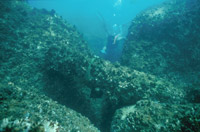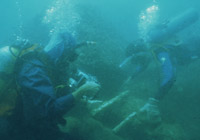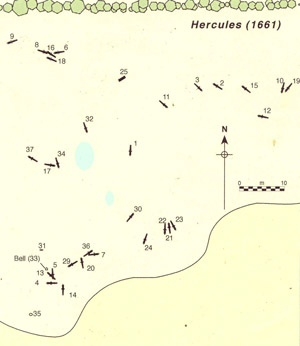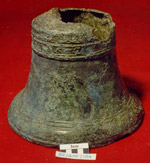 |
|
Maritime
Lanka Hercules 1661: • site Galle Research Subject index Image archive What's new People/contacts L |
5 May 2002
|
|||
| Last modified: 5 May 2002 |
 |
 |
 |
The site of the Hercules is in shallow water, just south of the rock seawall of Gibbet Island. Before this wall was built, there was a small bay between Gibbet and Closenberg Islands, and the Hercules lay just west of the entrance to this bay.
Scattered among large boulders are more than thirty iron cannon. Other finds have included iron shot, sounding leads, Dutch bricks, and the ship's bell. The site is exposed to heavy swells, particularly during the southwest monsoon, and it is not yet clear how much other material may survive under the seabed.
The site was preliminarily surveyed by the Galle Harbour Project in 1992-93. Immediately offshore are large boulders, which give way to a sandy seabed. A limited excavation was carried out at this sand-rock interface, in an attempt to determine whether archaeological material survived under the sand. Use of a water dredge around the group of three cannon closest to the interface revealed a number of concreted iron shot (round and bar), and a number of unidentified concretions. However, excavation in the sand area to a depth of about half a metre revealed only sterile and uniform sand-shell material. Further investigation of this site would be worthwhile.
The bell is of bronze, and inscribed 'AMOR VINCIT OMNIA ANNO 1625' (love conquers all, year 1625).
 Most
of the cannon are encrusted with concretion and marine growth. Among the more
open spread of boulders towards the western end of the site, three cannon have
been severely eroded, and in one example the bore passage has been exposed.
Most of the cannon are about 3 metres long, in their concreted state. One smaller
cannon has been noted, about 2 metres in length, part of a mid-site cannon cluster.
Most
of the cannon are encrusted with concretion and marine growth. Among the more
open spread of boulders towards the western end of the site, three cannon have
been severely eroded, and in one example the bore passage has been exposed.
Most of the cannon are about 3 metres long, in their concreted state. One smaller
cannon has been noted, about 2 metres in length, part of a mid-site cannon cluster.

| Maritime Lanka homepage | The Dolfijn 1663 |